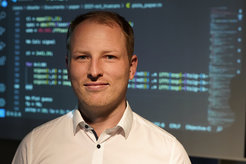Using shaped laser pulses to better understand molecules
ERC Starting Grant for Daniel Keefer
Whether solar cells or photosynthesis in plants: The interaction of light with molecules often plays a crucial role in chemical and physical processes. In many cases, however, the exact quantum mechanical processes are not sufficiently understood. It is difficult to investigate them experimentally, because some signals emitted by the molecules are hidden by signals that are superimposed on them. Daniel Keefer, group leader at the Max Planck Institute for Polymer Research, has now obtained an ERC Starting Grant to address this challenge using theoretical methods
Many chemical and physical processes are based on the interaction of light with molecules. Plants, for example, use sunlight to convert carbon dioxide and water into glucose and oxygen. A precise understanding of such photochemical reactions could open up new avenues for future technologies. Examples include photocatalysis, in which molecules can be split using light, such as water into oxygen and hydrogen, and photovoltaics, in which sunlight can be used to generate electricity.
The interaction between light and molecules is based primarily on the fact that electrons, which move around the molecule in a kind of cloud, interact with the light: Light particles - called photons - can be absorbed, for example. Such processes, and in particular their speed, can be studied using ultrashort laser pulses. These pulses can be as short as a millionth part of a billionth of a second, making it possible to take snapshot images of the state of molecules.

However, molecules do not reveal all of their information experimentally, as Daniel Keefer, group leader in Mischa Bonn's department, knows: "Some of the quantum mechanical processes that take place on these short time scales leave only very weak signatures in experiments."
Keefer is working on theoretical methods to make these hidden signatures measurable. "In the theory I'm working with, all the molecular signatures are available without restriction - that means I can calculate how the laser pulses need to be modified to measure these signatures as optimally as possible," Keefer says,
His approach is to "shape" the laser pulses used to irradiate the molecules - an approach that originated in quantum control. "Such a laser pulse consists of a relatively broad spectrum of colors," Keefer explains. "One can now ensure, for example, that the laser pulse is more red at its beginning and more blue at its end, but also vice versa."
Keefer's goal is to calculate the exact design of laser pulses in theory so that they can be used to measure the quantum mechanical signature as well as possible in later experiments. A large part of these experiments will be carried out on free-electron lasers, such as those in Hamburg, Trieste and Stanford. In addition to visible and infrared laser pulses, for which complex pulse shaping is already established, high-energy X-ray pulses are also available at these relatively new laser facilities. Due to their higher energy and smaller temporal length, these allow even more detailed insight into molecular photochemistry. To pursue his goal, he has now obtained an ERC Starting Grant with the TU Munich, which will be transferred to the MPI for Polymer Research in Mainz for launch. The project "Quantum Controlled X-ray Spectroscopy of Elementary Molecular Dynamics" (QuantXS), with a funding volume of 1.4 million euros, has a duration of 5 years.
About Daniel Keefer
Daniel Keefer studied at LMU Munich, where he received a bachelor's degree in chemistry and biochemistry (2012) and a master's degree in chemistry (2014). Daniel then joined the group of Prof. Regina de Vivie-Riedle at LMU and received his PhD in theoretical chemistry in 2019, where he worked on quantum molecular dynamics in complex environments and optimal quantum control. Daniel then moved to the University of California at Irvine for his postdoctoral studies, supported by a Feodor Lynen Research Fellowship from the Alexander von Humboldt Foundation. In Prof. Shaul Mukamel's group, he worked on the development and simulation of ultrafast X-ray spectroscopy to study molecular photochemistry. In 2023, he joined the Max Planck Institute for Polymer Research in Mainz as a group leader in the Molecular Spectroscopy Department.












